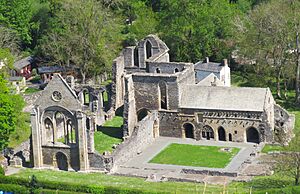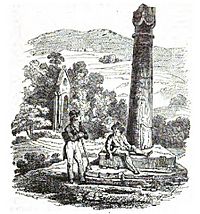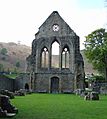Valle Crucis Abbey facts for kids
Quick facts for kids Valle Crucis Abbey |
|
|---|---|
 |
|
| Religion | |
| Affiliation | Catholicism, Cistercians |
| Ecclesiastical or organizational status | Ruins. Abbey dissolved 1537. |
| Year consecrated | pre 1236 |
| Location | |
| Location | Llantysilio, Denbighshire, Wales |
| Architecture | |
| Architectural type | Monastery |
| Architectural style | Cistercian |
| Groundbreaking | 1201 |
Valle Crucis Abbey (which means "Valley of the Cross") is an old Cistercian abbey in north Wales. It's located in a place called Llantysilio in Denbighshire. This historic site was once known as the Abbey Church of the Blessed Virgin Mary, Valle Crucis. In Welsh, it's called Abaty Glyn Egwestl or Abaty Glyn y Groes.
The abbey was built in 1201 by Madog ap Gruffydd Maelor, a prince from Powys Fadog. Sadly, Valle Crucis Abbey was closed down in 1537 during a time when many monasteries were dissolved. After that, it slowly fell apart. Today, it's a beautiful ruin, but many parts of the original building still stand. Cadw, a Welsh government body, now looks after Valle Crucis Abbey, and many visitors come to explore its history.
Contents
History of Valle Crucis Abbey
Valle Crucis Abbey was started in 1201 by Prince Madog ap Gruffydd Maelor. It was the very last Cistercian monastery built in Wales. The abbey was in the area of Powys Fadog, in an ancient region called Iâl (Yale). It was the spiritual heart of the area, while Dinas Bran was the main political castle.
The abbey got its name from a nearby stone monument called the Pillar of Eliseg. This pillar was put up about 400 years earlier by Cyngen ap Cadell, a King of Powys. He built it to remember his great-grandfather, Elisedd ap Gwylog.
Early Years and Challenges
When Prince Madog died in 1236, he was buried in the abbey he helped complete. Not long after his death, a big fire likely damaged the abbey. Archaeologists have found proof that the church and the southern part of the buildings were affected.
Valle Crucis began as a small group of twelve monks from Strata Marcella, an older abbey near Welshpool. They first built temporary wooden structures. Later, these were replaced with strong stone buildings. It's thought that the completed abbey could house about sixty people. This included 20 choir monks and 40 lay-members who did daily tasks like farming.
The number of monks changed over time due to different events. The abbey faced challenges during the Welsh Wars in the 13th century, when Edward I of England was fighting in Wales. It was also likely damaged during the uprising led by Owain Glyndŵr. The terrible Black Death also caused the number of monks to drop significantly.
Later Prosperity and Dissolution
Things got better for Valle Crucis in the 15th century. The abbey became known as a welcoming place for travelers. Several important Welsh poets, like Gutun Owain, Tudur Aled, and Guto'r Glyn, spent time there. Guto'r Glyn even spent his last years at the abbey and was buried there in 1493.
However, in 1537, Valle Crucis Abbey was closed down. This happened during the dissolution of the monasteries ordered by Henry VIII. The abbey was considered less wealthy than some English abbeys, so it was dissolved. After this, the buildings started to fall apart.
The land was first leased to Sir William Puckering or Pickering for 21 years. After his death, it passed to his daughter, Hestor. She married Edward Wotton, 1st Baron Wotton, and the lease was extended by Elizabeth I. By the late 1500s, the eastern part of the abbey was turned into a manor house.
The abbey stayed with the Wotton family for a while. Later, it was sold when the estate was taken by Parliament in 1651. By the late 1700s, some remaining buildings were re-roofed and used as a farm. In the late 1800s, people started digging to uncover more of the abbey. Today, Cadw cares for the site, and it's open for visitors. A caravan park now surrounds the ruins on three sides.
Exploring the Abbey's Architecture
Valle Crucis Abbey was made up of the main church and several other buildings. These buildings formed a square courtyard in the middle. The church itself was built in a traditional cross shape, running from west to east. Today, much of the church is in ruins, but the tall west end front wall still stands. You can still see the beautiful stone work of the rose window there.
Inside, the church was divided by a screen called a pulpitum in the 14th century. This separated the lay brothers, who worshipped at an altar in front of the screen, from the choir monks, who used the main altar and side chapels.
Surviving Structures
The buildings around the courtyard included the east range, which is mostly still standing. The west range, which held the lay brethren's dining hall (called a frater), is now gone. The southern dining hall and kitchen, which faced the church, are also mostly ruins, with only their foundations left.
The east and west ranges also contained the cloisters, which were covered walkways around the courtyard. The east range led to the abbot's lodgings, where the head of the abbey lived. Valle Crucis also has the only remaining monastic fishpond in Wales, though it was changed into a reflecting pool in the 1700s.
Besides the west end wall, many parts of the eastern side of the abbey are still here. The walls of the chancel (the area around the altar), part of the south transept (the arms of the cross-shaped church), and the east range of the cloister are mostly intact. This includes the chapter house (where monks met) and the sacristy (where sacred items were kept). The lower part of the reredorter (the latrine block) also survives.
In 1870, the west end wall was repaired by George Gilbert Scott. Unusually for a ruined monastery, you can still access parts of the first floor, like the dormitory and the abbot's lodgings. Some items from the abbey, like the font, were moved to nearby places like Plas Newydd, Llangollen by the Ladies of Llangollen in the late 1700s.
Images for kids
See also
 In Spanish: Abadía de Valle Crucis para niños
In Spanish: Abadía de Valle Crucis para niños















